Monday, January 16, 2006
Momote-sai Festival in Yasu
 Many of our traditional ceremonies held at Shinto shrines are highly ritualized and often performed very seriously. The audience is usually supposed to keep quiet while the ritual is being performed in front of the god(s). The atmosphere of the Momote-sai (百手祭), a festival held last Sunday in a town called Yasu, however, was so friendly that I believe all the visitors there felt really at home.
Many of our traditional ceremonies held at Shinto shrines are highly ritualized and often performed very seriously. The audience is usually supposed to keep quiet while the ritual is being performed in front of the god(s). The atmosphere of the Momote-sai (百手祭), a festival held last Sunday in a town called Yasu, however, was so friendly that I believe all the visitors there felt really at home.Perhaps the friendly atmosphere had something to do with the fact that I saw only the 2nd day of the festival, not the 1st. Momote-sai is a traditional bow-shooting festival which is celebrated in several places in Japan. In Yasu town, the festival is held every year in January on the second “day of the hare and day of the dragon” of ancient Chinese calendar, and most of the formal rituals are performed on the day-1. This year, those two days fell on the 14th and the 15th, so the formal part was finished on Saturday.
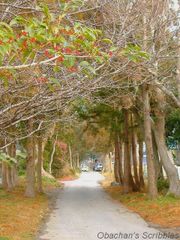 According to several websites, Momote-sai has started in Yasu more than 400 years ago. There are several different stories about the origin of the festival, but the most popular one holds that it started to praise a hero who shot to kill a monstrous beast called “ushioni (cow-shaped ogure?)” that had been causing troubles there. The events on day-1 include the ceremonies of distributing bows to the twelve shooters, drinking “sacred sake” and bow-shooting, all performed by the participants in formal traditional costumes. They say that shooters used to cleanse their bodies in the ocean the day before the festival, but that part of the ritual is not observed any more.
According to several websites, Momote-sai has started in Yasu more than 400 years ago. There are several different stories about the origin of the festival, but the most popular one holds that it started to praise a hero who shot to kill a monstrous beast called “ushioni (cow-shaped ogure?)” that had been causing troubles there. The events on day-1 include the ceremonies of distributing bows to the twelve shooters, drinking “sacred sake” and bow-shooting, all performed by the participants in formal traditional costumes. They say that shooters used to cleanse their bodies in the ocean the day before the festival, but that part of the ritual is not observed any more. The shooters are supposed to shoot more than 1200 times in total of two days. On the day-2, the shooters just continue shooting, in less formal traditional costumes, to complete the required number of shots, and that was what I saw on Sunday.
The shooters are supposed to shoot more than 1200 times in total of two days. On the day-2, the shooters just continue shooting, in less formal traditional costumes, to complete the required number of shots, and that was what I saw on Sunday.I think it was past 10 am when I got to Nishiyama hachimangu shrine after asking a few people directions at the convenience store near JR Yasu station. I loved walking on the tree-lined path leading from the gateway to the main shrine. At the shrine, the shooting was already started.
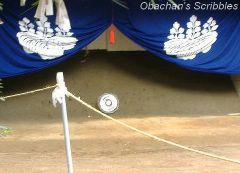 This was the target. It is said that a Chinese Character, “鬼(ogure)” is drawn in the center of the target first, then painted over to have the concentric circles drawn on the surface. So the shooters are considered to be shooting the ogure, just like their ancient hero did.
This was the target. It is said that a Chinese Character, “鬼(ogure)” is drawn in the center of the target first, then painted over to have the concentric circles drawn on the surface. So the shooters are considered to be shooting the ogure, just like their ancient hero did.The shooters were shooting from the east end of the shrine to the target located in the west.
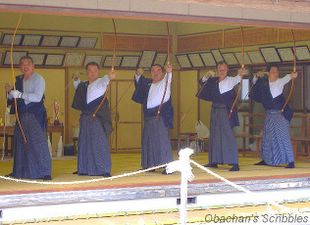
As I was watching the ceremony, an elder man came to me to give me a nice hot ameyu (sweet ginger drink) in a small paper cup. Then a few other elder men told me one after another, "Hey, come! Have a potato!" and led me to this place :)
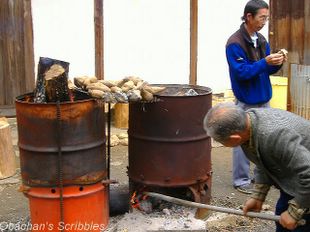
Yes. They were baking bunch of sweet potatoes, and looked like taking care of those potatoes was a very important work.They offered visitors baked sweet potatoes one after another, and I got an amazingly big one. When I found that it wasn’t done inside, they told me to bury it in the ash. The atmosphere was so laid back and everyone, including the audience, was joking around all the time.
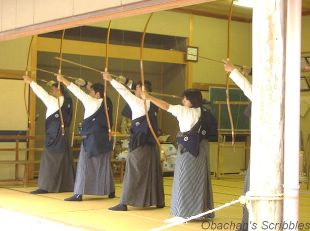
The friendly man who was taking care of the potatoes told me some detailes of the ceremony. According to him, the distance betw. the target and the shooters was apx. 20 meters. The fence surrounding the target was built about 10 years ago because when there was no fence, an arrow that missed the target hit a neighbor’s house. He also told me how difficult it is every year to secure 12 shooters. Not many young people are interested in the festival, and if someone in a shooter’s family or extended family dies, the shooter cannot join the ceremony until the next year. (We say here that you are not supposed to participate in Shinto-related activities until the mourning period is over.)
There used to be male shooters only, but the first female shooter joined this festival in 2002, according to him. It is probably true that people in Kochi are more open about having female in male-dominant fields, but I guess the lack of successors is undoubtedly playing a big role there, just like in many other underpopulated areas. At my parents’ house in my hometown, I’ve done some rituals in my childhood that women were not supposed to do, because I have no male siblings. ;P
He also told me that some of the shooters belonged to Japanese archery clubs at school when young, but most of the clubs do not exist any more. When they were desperately short of hands, he said, they taught a total beginner how to shoot just for this festival and had him practice at the shrine every day for certain period of time before the festival.
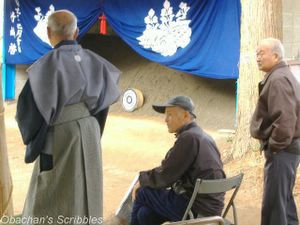 The man sitting in the chair was in charge of hitting a big empty oil can every time there was a good hit. The people taking care of this festival friendlily teased the shooters like “Hey, we haven’t heard the sound of the can for a long time, ” or “You guys aren't drunk enough, huh?” Right beside the shooter’s hut, kids were cheering, “Go for it, dad!” And some shooters were drinking sake in the back row when it wasn't their turn to shoot.
The man sitting in the chair was in charge of hitting a big empty oil can every time there was a good hit. The people taking care of this festival friendlily teased the shooters like “Hey, we haven’t heard the sound of the can for a long time, ” or “You guys aren't drunk enough, huh?” Right beside the shooter’s hut, kids were cheering, “Go for it, dad!” And some shooters were drinking sake in the back row when it wasn't their turn to shoot.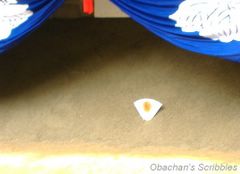 After a certain number of shots, the target was changed to a fan with a character “鬼(ogure)” written in the red circle in the center. When an arrow hit between the spines of the fan, we all clapped and cheered!
After a certain number of shots, the target was changed to a fan with a character “鬼(ogure)” written in the red circle in the center. When an arrow hit between the spines of the fan, we all clapped and cheered!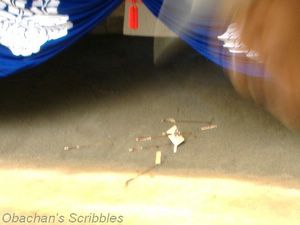 And there came a smaller wooden plate with “鬼(ogure)” written in the center. Everyone thought that it’d be a while before someone would have a good shot, so all the photographers there including myself were totally unprepared when an arrow suddenly hit and cracked the target! We were too excited and most of us forgot about photo-taking.
And there came a smaller wooden plate with “鬼(ogure)” written in the center. Everyone thought that it’d be a while before someone would have a good shot, so all the photographers there including myself were totally unprepared when an arrow suddenly hit and cracked the target! We were too excited and most of us forgot about photo-taking.Finally they used daidai orange hung with a string as the target. All the photographers incl. myself held our breath this time to get the shot of the very moment of an arrow piercing the orange. The friendly festival staff (elder men) brought things one after another like a chair, big woodpiece or empty oil can so that the photographers could put cameras on. They said to us “Hey, don’t miss the shot this time!” and joked to the shooters “Maybe you have a better luck if we swing the orange?” It was so funny. Unfortunately no one hit the orange target, though one shot was really close and we all thought that the feather part touched the orange, but it wasn't counted as a hit.
BTW, last year at every festival I visited, I always saw more than one middle-aged (often much older than I) female photographers with professional-looking big cameras. I often wondered if it was the policy of the media in Kochi to hire predominantly female photographers or if there are more free-lance female photographers in Kochi than other prefectures. At this Momote-sai, the relaxed atmosphere made it easier for the photographers to socialize and I found that some of them were amateurs who love local traditional festivals so much and have their websites to upload the festival photos.
One of the 12 shooters told his daughter to pose for us.
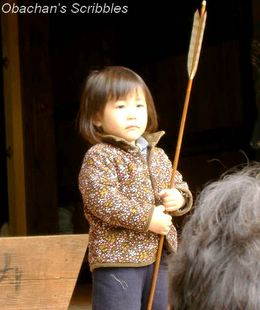
Daddy told me to hold this thing and stand here, but how long do I have to do this???
 Then an elder lady came to pray to the god. We (the amateur photographers) thought it would be a good picture, but as soon as she sat there to pray, the shooters started changing clothes in the background! :O It was so hilarious!! We ended up with shots of a religious elder lady with middle-aged guys in underwear in the background … We all laughed so hard.
Then an elder lady came to pray to the god. We (the amateur photographers) thought it would be a good picture, but as soon as she sat there to pray, the shooters started changing clothes in the background! :O It was so hilarious!! We ended up with shots of a religious elder lady with middle-aged guys in underwear in the background … We all laughed so hard. Countless omikuji (paper fortunes) were tied to trees at the shrine.
Countless omikuji (paper fortunes) were tied to trees at the shrine.Maybe because the bow-shooting performance is more athletic in nature and continues for as long as two days at this festival, both participants and onlookers were so relaxed. But that may not be the only reason for the friendly atmosphere of Momote-sai in Yasu. The history says that when Lord Yamanouchi came to rule this district in the feudal era, he tried to discontinue many of the community-based traditions, but the people in Yasu argued that they had to continue this Momote-sai and finally won a permission from the new lord. It must have been something really brave to do at that time, and I think that shows how much this festival is loved in this small town. I really like this kind of story.
Feeling so warm inside (not only from the hot ameyu and yakiimo) I left the shrine.
There was one camellia tree in full bloom on the roadside.

I walked back to the station, but didn’t feel like going straight home, so I had a snack in the beachiside park called “Ya-shii park.”

It was so nice and refreshing to see the ocean and families playing on the beach.
posted by obachan, 1/16/2006 01:19:00 PM


